Editors of this issue: Antanas Klimas, Ignas K. Skrupskelis

|
LITUANUS
LITHUANIAN QUARTERLY JOURNAL OF ARTS AND SCIENCES
Volume 18, No.1 - Spring 1972
Editors of this issue: Antanas Klimas, Ignas K. Skrupskelis Copyright © 1972 LITUANUS Foundation, Inc.
|

|
THE DURATION OF THE LONG VOWELS AS A PERCEPTUAL CUE IN LITHUANIAN
MARC L. SCHNITZER
The Pennsylvania State University
1. Ten of the Lithuanian vocalic phonemes have been traditionally described as long and short a, e, i, o, and u.1 And they are generally transcribed as follows:
/a:/, /e:/, /i:/, /o:/, /u:/
/a/, /e/, /i/, /o/, /u/, (":" denotes length)
But upon hearing these vowels pronounced by a native Lithuanian, they seemed to be transcribable as follows:
|
/a:/ /a/ /e:/ /e/ /i:/ /i/ /o:/ /o/ /u:/ /u/ |
[a:] [A] [æ] [E] [i:] [I] [o:] [o] [u:] [U] |
That is, it seemed that there was a difference of tongue height in addition to duration between the (phonemically) long and short varieties of each of the vowels.
2. The question then arose as to whether duration was a necessary cue for the identification of a vowel in Lithuanian, or whether a native speaker could identify whether a given vowel was phonemically "long" or "short" without the cue of duration.
3. The following test was devised: a native Lithuanian pronounced all ten vowels listed above; they were recorded on magnetic tape at 15 in./sec. The vowels were uttered in isolation in order to achieve a steady-state value, if possible. The pieces of tape containing the vowels were then severed from the reel tape and measured; these lengths to the nearest 0.5 mm. were as follows:
|
Short Vowel |
Length |
Long Vowel |
Length Before Cutting |
Length After Cutting |
|
/i/ /u/ /o/ /e/ /a/ |
71 mm 70 mm 101 mm 83.5 mm 77 mm |
/i:/ /u:/ /o:/ /e:/ /a:/ |
137 mm 155 mm 159.5 mm 189 mm 190 mm |
71 mm 70 mm 101 mm 83.5 mm 77 mm |
Then, the (initial and terminal) ends were cut from each piece of tape containing a long vowel thereby modifying the lengths such that the length of tape containing each long vowel was then the same as the length of tape containing the corresponding short vowel (± 0.5 mm). The pieces of tape containing the vowels were then put back onto a reel by splicing them with leader tape and their order was scrambled. The test could now take place: the same informant as had produced the vowels was asked to listen to the tape. He was instructed that every time he heard a vowel he was to transcribe it with one of the following ten symbols for Lithuanian vowels a:, e:, i:, o:, u:, a, e, i, o, u. If he were able to transcribe the vowels successfully, strong evidence would be provided that vowel length (duration) is not a necessary cue for the identification of the "long" and "short" Lithuanian vowels. Conversely, his not being able to transcribe them accurately would yield evidence that length was a necessary perceptual cue.
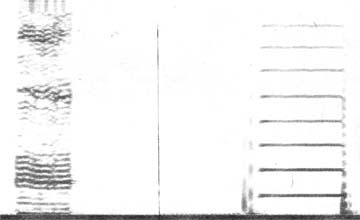
Lithuanian a: (wide band) calibration tone
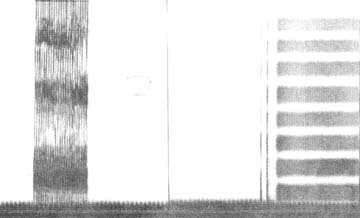
Lithuanian a: (narrow band) calibration tone
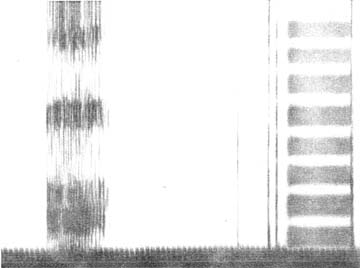
Lithuanian a (wide band) calibration tone
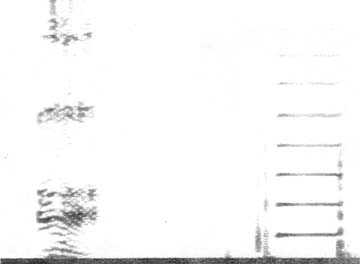
Lithuanian a (narrow band) calibration tone
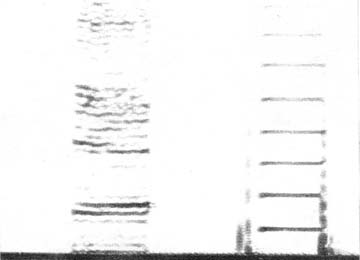
Lithuanian e: (wide band) calibration tone
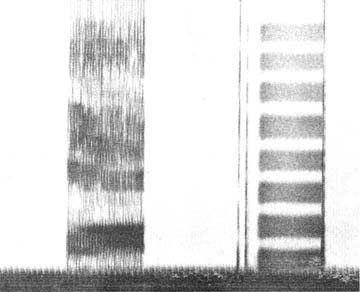
Lithuanian e: (narrow band) calibration tone
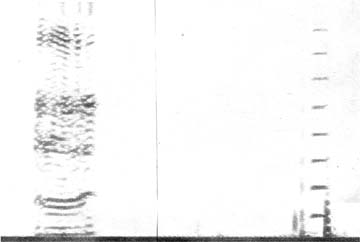
Lithuanian e (narrow band) calibration tone
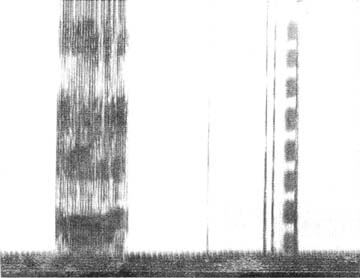
Lithuanian e (wide band) calibration tone
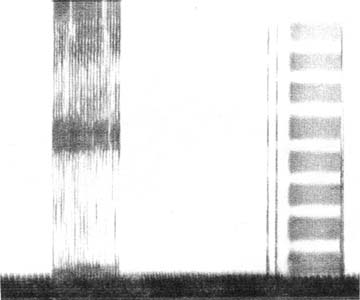
Lithuanian i: (wide band) calibration tone
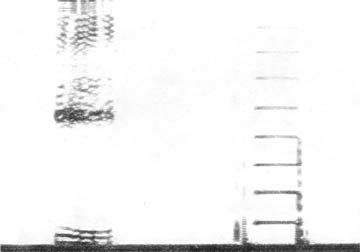
Lithuanian i: (narrow band) calibration tom
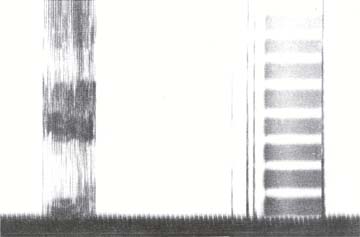
Lithuanian i (wide band) calibration tone
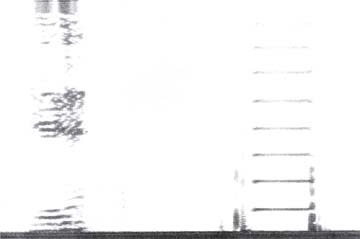
Lithuanian i (narrow band) calibration tone
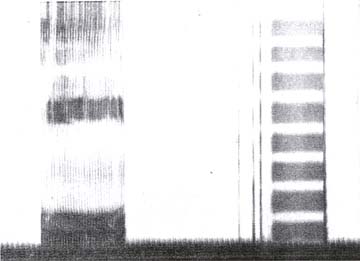
Lithuanian o: (wide band) calibration tone
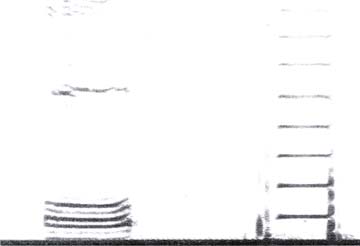
Lithuanian o: (narrow band) calibration tone
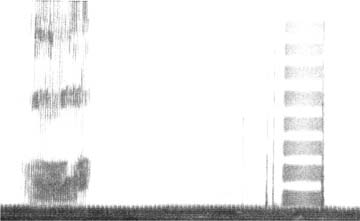
Lithuanian o (wide band) calibration tone
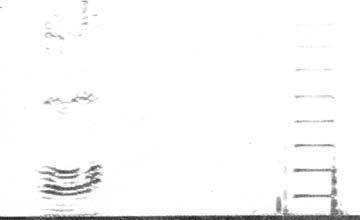
Lithuanian o (narrow band) calibration tone
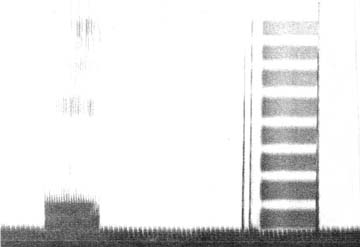
Lithuanian u: (wide band) calibration tone
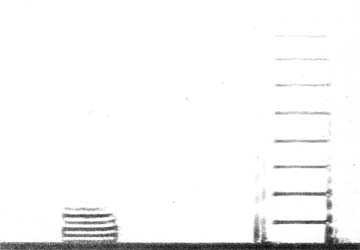
Lithuanian u: (narrow band) calibration tone
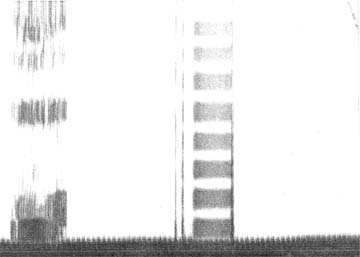
Lithuanian u (wide band) calibration tone
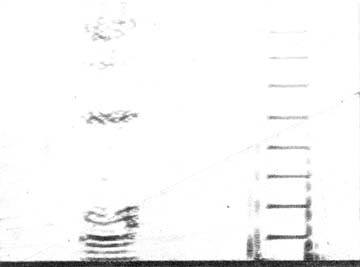
Lithuanian u (narrow band) calibration tone
4. The informant was first allowed to listen to each vowel as many times as desired before transcribing, (with the one restriction that after he had heard the next vowel he would not be allowed to hear a previous vowel again). He was then asked to transcribe the vowels again, this time hearing each vowel only once. Both times he was successful in transcribing each vowel correctly (even though the cue of duration was absent from the a:, e:, i:, o:, u:, series) with the following exception:
on the first trial, the subject wrote for /u:/ "in between u: and u"
and on the second trial he wrote "u".
Hence, the subject seemed to have trouble distinguishing between /u:/ and /u/ when the cue of duration had been removed.
5. Since the first formant of a vowel has been found to correlate roughly with the articulatory parameter of tongue height,2 (and since, as mentioned in section 1, a difference in tongue height between /u:/ and /u/ was
detected by the investigator) spectrograms were made of all ten vowels of the reel using the Kay Sona-Graph 6061A with scale of approximately 0-4500 cps. But knowledge of the exact scale was not needed since the machine is provided with a calibration tone which marks every 500 cps, which was all that was needed since F1 was the only formant likely to be relevant, and since there was no reason to expect anything of interest from formants higher than F3. The hypothesis was that the difference between the F1's of /u:/ and /u/ was substantially less than the F1 differences for the four other sets of long and short vowels (and that this might account for the /u:/ /u/ confusion). The following are the results of the measurements:
| (the measurements are ±25 c. p. s.) | |||
| Vowel | F1 | F2 | F3 |
|
/o:/ /o/ /u:/ /u/ /a:/ /a/ /i:/ /i/ /e:/ /e/ |
450 600 300 450 750 800 250 450 800 700 |
700 950 600 750 1100 1150 2350 2000 1700 1750 |
2600 2350 2500 2400 2550 2600 ?(2600-3000) 2500 2150 2450 |
6. The hypothesis was thus not verified: the difference between the F1's of /u:/ and /u/ was 150 cps; this difference is greater than or equal to the differences in F1's for three of the four other sets:
/e:/, /e/
/o:/, /o/
/a:/, /a/.
Also, F2 and F3 differed substantially between /u:/ and /u/.
7. One must conclude (for the informant used) for the pairs /a:, a/, /e:, e/, /i:, i/ and /o:, o/, that duration (or length) is not a necessary cue for vowel identification and differentiation (within each pair). Apparently no spectrographic data (in terms of the first three frequencies) was able to account for the fact that the informant was not able to distinguish between /u:/ and /u/ in the absence of the cue of duration.
One is then forced to conclude that (at least in the receptive idiolect of the informant used) the major cue for the differential perception of /u:/ or /u/ is (most probably) length (that is duration of the vowel) rather then (e. g.) tongue height (or any other parameter which could be correlated with formant frequencies).
1 Dambriūnas, Leonardas, and Klimas, Antanas, and Schmalstieg, William R., Introduction to Modern Lithuanian, Franciscan Fathers Press, Brooklyn, New York, 1966, pp. 4-7. (There is, of course, the additional long vowel /ė/, which is not considered herein, since it has no short counterpart.)
2 Peterson, Gordon E., and Barney, Harold L., "Control Methods Used in a Study of the Vowels", pp. 175-84 in JASA, 24, 2, 1952, p. 178.